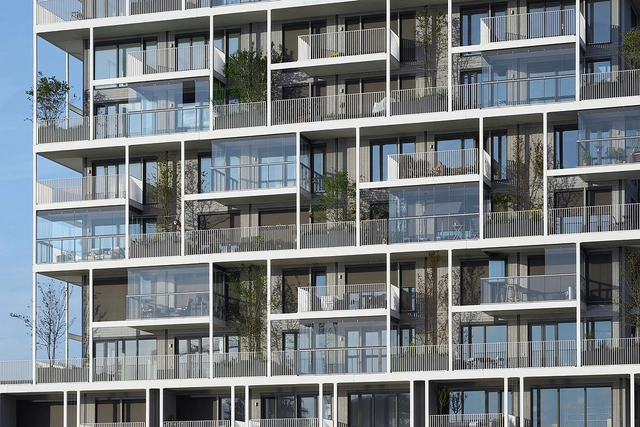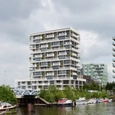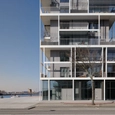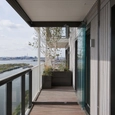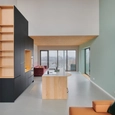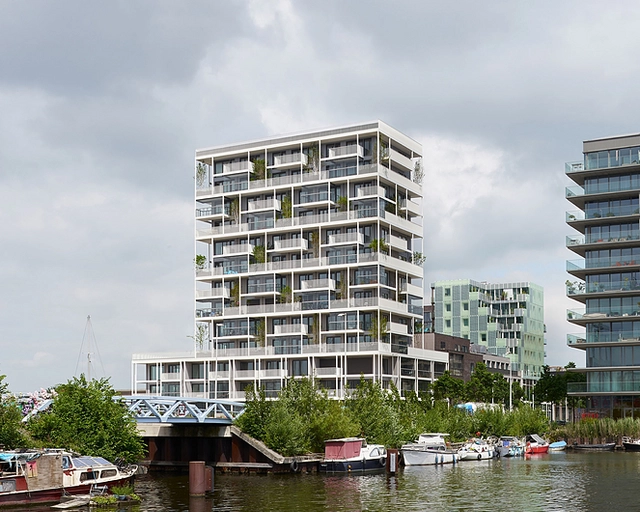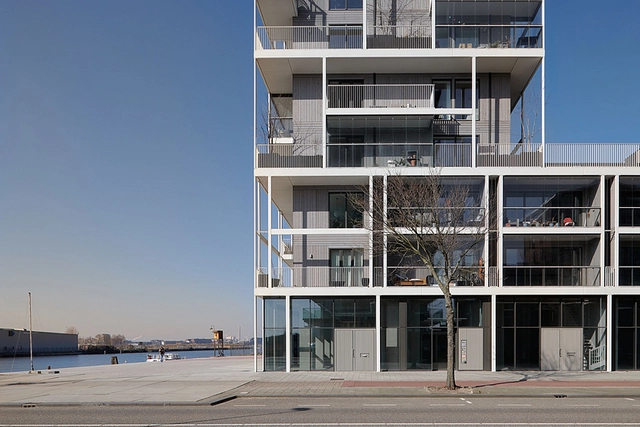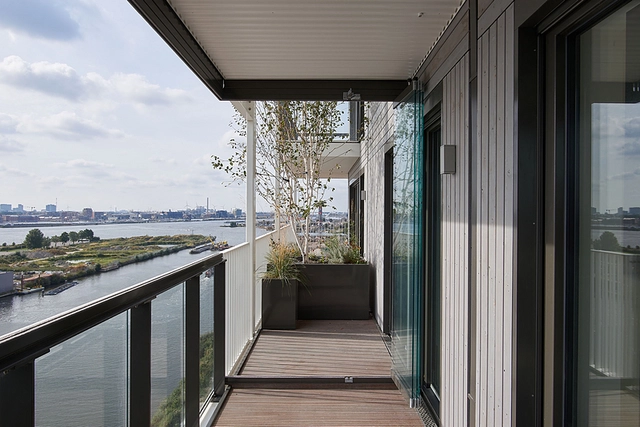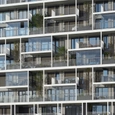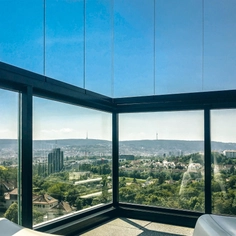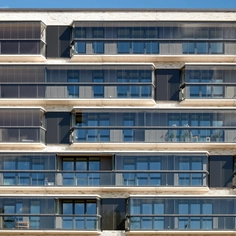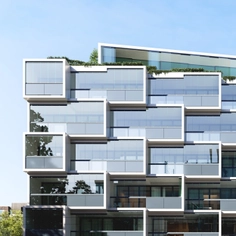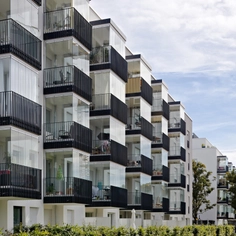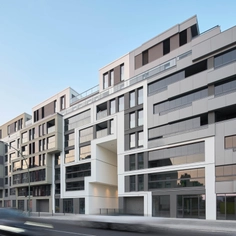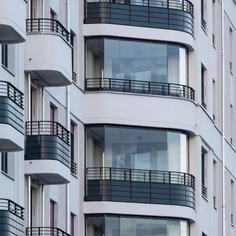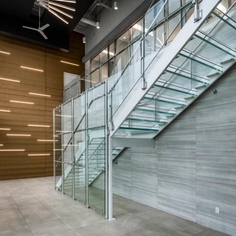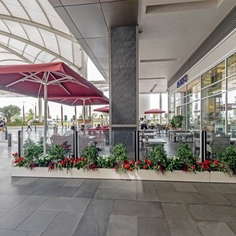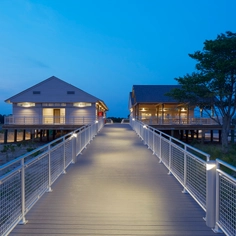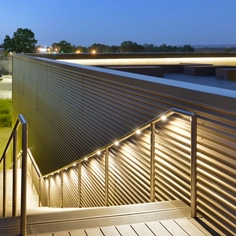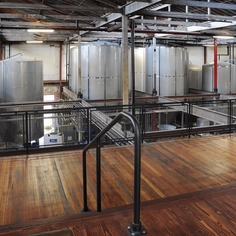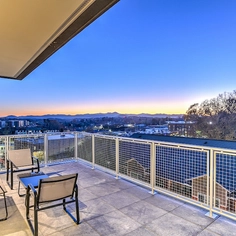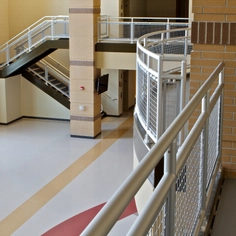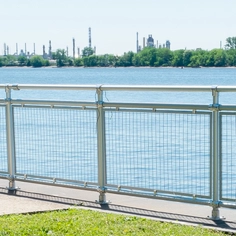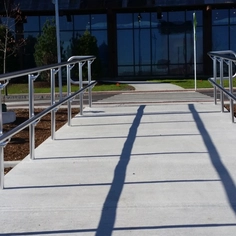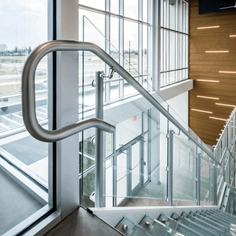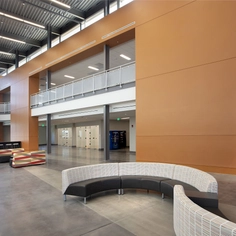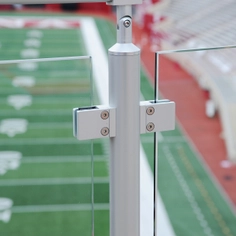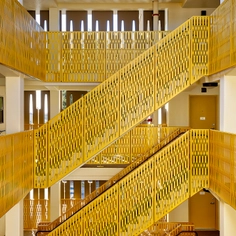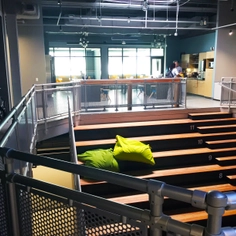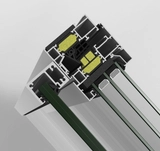-
Use
Balcony glazing -
Applications
High-rise, hybrid building -
Characteristics
Frameless glass system, optimum protection against wind and weather, enhanced sound insulation, slide-and-turn system
By 2030, the Polder Buiksloterham business park in north Amsterdam is set to become a model district with closed material cycles. Due to the economic situation when the project began around 15 years ago, the City of Amsterdam decided in favor of a slower, more sustainable transformation strategy. The Stories apartment building, planned by Olaf Gipser Architects, is among the new buildings in the mixed-use area characterized by consortium projects and zero-energy structures, situated alongside logistics companies and DIY shops. The structure is 46 meters tall and has 13 stories. The upper ten levels were built using wood-framing techniques. The building, wrapped in a delicate white steel facade with high niches for plants, features Solarlux transparent balcony glazing for flexible and almost invisible weather protection.
Sustainable Living Space for Building Consortia
One of the municipality’s prerequisites outlined that construction should be executed with materials that could, to a great extent, be returned to the material cycle. This is how Olaf Gipser had the idea for a wood-hybrid building with greened facades. Altogether, the building comprises 29 individually designed flats and six commercial units. The apartments have a ceiling height of 2.90 m and measure from 43 to 235 m2. The base as well as the 7th and 11th upper levels are each home to a loft apartment extending over two levels.
As no one back in 2015 dared construct a 13-story building entirely of wood, and because a parkade for 40 cars was required on the ground floor, the three-story base of concrete came to be. Above it rises the 32,5-m wood-framed tower, which has a concrete access core. The architects shifted the tower to the roadside of the building to ensure that enough space remained at the western end of the base for a communal rooftop terrace, where residents now practice urban farming.
A High-Rise of Laminated Timber
The tower construction is of laminated timber. For every level, 15 load-bearing elements with thicknesses from 160 to 240 mm form a grid with an axial dimension of 4,80 m. These wooden portals have large openings that enable a flexible arrangement of up to six flats per level. To enable future changes, more door openings than necessary have been cut into the corridor walls. The greatest possible degree of flexibility was important not only to the building consortium but to the architects as well. Olaf Gipser belongs to a network of 14 up-and-coming studios that has published a Dutch Open Building manifesto. This includes the integration of possible future changes in arrangement or function as an indispensable component of sustainability.
Flexibility vs. Acoustics
To a certain extent, with this project, the desired flexibility had to give way to acoustics and fire protection. In order to meet fire-protection standards, the separating walls in the apartments have been clad with drywall, which also supports soundproofing. However, to ensure that the wood construction can still be experienced by residents, the architects calculated the burnup rate for the ceiling elements and left their undersides exposed to view. Inside the flats, the wooden ceilings contrast with the white-plastered sheetrock walls. The upper sides of the ceiling elements have been layered with 100 mm of foam concrete; above this, there is a 40-mm layer of footfall-sound insulation.
A Prefabricated Façade with a Steel Frame
The facades consist of prefabricated wooden skeleton elements that were delivered with 300 mm of thermal insulation and floor-to-ceiling wood-framed windows. Cladding of spruce slats that have been pre-greyed, heat-treated, and treated with flame retardant protects the façades from the North Sea climate. In front of this, there is a 2-meter-deep steel rack featuring balconies stacked two by two and separated from their neighboring balconies by plant niches that are six meters tall. On three sides of the building, each niche is home to a multi-trunked tree surrounded by undergrowth comprising shrubs, herbs, and grasses. On the north-facing side, the rack is only 1,5 m deep and features climbing plants.
Floating Gardens as Biodiverse Living Space
The architects’ goal is to have the deep, green facade serve not only as outdoor space, a privacy shield, sunscreen, and particulate filter but also as a living space for insects and birds. Seen from the apartments, the green niches present themselves as small floating gardens. From the perspective of passers-by, the steel façade above all creates a light, elegant view of the building that changes constantly with the season's thanks to the various foliage colors of the five tree species.
Flexible Weather Protection
The transparent balcony glazing protects the building structure and the exterior areas of the flats from wind, weather, and noise. It can be opened flexibly and accentuates the delicate appearance of the steel facade. Furthermore, it interacts with the vertical columns of the banisters to enliven the face of the building. As a thermal buffer, it also increases the building’s energy efficiency. Its intuitive functionality is based on the slide-and-turn principle: each glass element can be slid to the side and turned 90°. The elements can be set aside as narrow packets of glass. This function enables each balcony facade to be opened nearly 100 percent.
Due to the various balcony sizes, story heights, and positions in the building, the glazing is either room height –providing access to the floating gardens– or has been mounted onto a glass balustrade. Altogether, twelve different configurations of Solarlux’s SL 25 (on-balustrade) or SL 25 XXL (room-height) systems were employed here. These configurations include variants with glass elements that run around both corners so that the formerly sheltered balcony can be completely opened on all sides.
Project Details
| Architects | Olaf Gipser Architects |
| Location | Amsterdam, Netherlands |
| Year | 2022 |
| Products | Solarlux SL 25, Solarlux SL 25 XXL |


